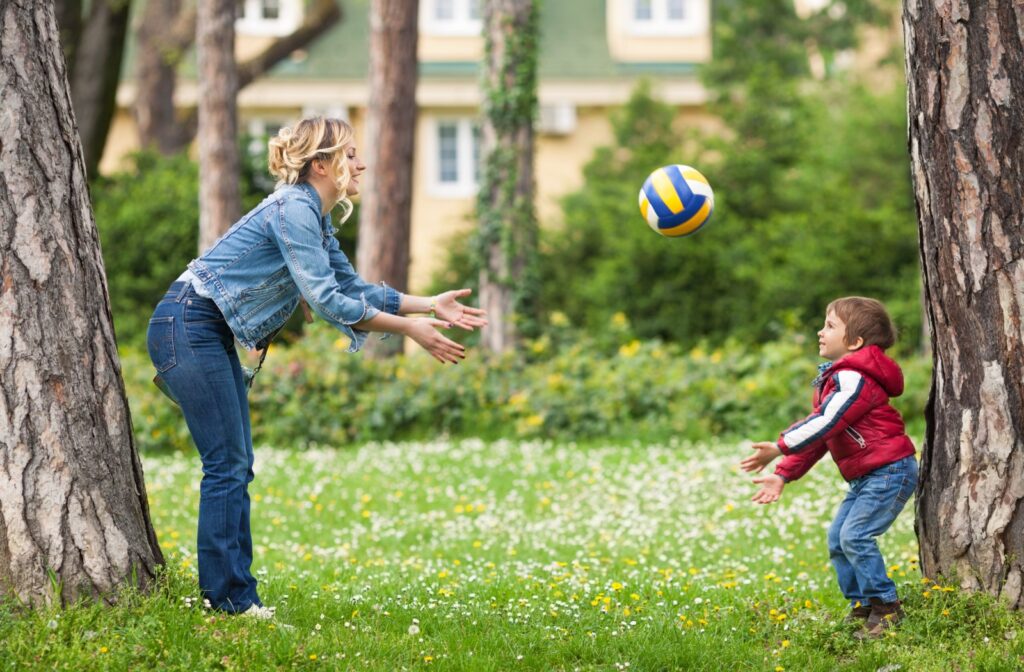The ability to see is something most of us take for granted, which is why we often don’t realize that vision is a complex process involving more than just our eyes. In fact, vision is a teamwork effort between your eyes and your brain: your eyes might do the actual “seeing”, but your brain interprets what your eyes perceive.
But what happens when the brain and eyes aren’t on the same page? Difficulties like poor eye-hand coordination, depth perception issues, and even headaches can arise. The good news? Vision therapy can help strengthen this critical connection.
The Brain-Eye Connection
Your eyes might do the “seeing,” but your brain does all the interpreting. Here’s how the process works:
- When light enters your eyes, it’s converted into electrical signals by the retina.
- These signals travel along the optic nerve to the brain’s visual cortex.
- The visual cortex then processes these signals into images, assigns meaning to them, and combines them with other sensory inputs.
This system allows us to perceive depth, track movement, and coordinate actions with precision.
Think of it as teamwork between a sports coach (your brain) and the players on the field (your eyes). When they work in harmony, everything runs smoothly. When one falters, the whole team feels the effects.
What Is Binocular Vision?
Binocular vision is a key aspect of brain-eye connection. It refers to the way both eyes work together to create a single image. Each eye captures a slightly different view of the world, and the brain blends these views seamlessly to create depth perception.
For example, when parallel parking, binocular vision helps you gauge the distance between your car and the one behind you. But if your eyes don’t align properly, you might experience double vision or struggle with spatial perception, making even everyday tasks tricky.
Visual Skills: The Key to Smooth Brain-Eye Communication
Strong visual skills are essential for effective brain-eye coordination. These skills include:
- Tracking: Following moving objects, like a ball or a car, with your eyes.
- Convergence: Turning both eyes inward to look at a close object, such as a book or your phone screen.
- Depth Perception: Judging how far away objects are, which is key for tasks like walking or reaching for something on a shelf.
- Focus Flexibility: Quickly shifting focus between objects at different distances, like glancing from your computer screen to your coffee cup.
- Fusion: The capacity of the eyes to work together to see a single image.
- Divergence: The ability of the eyes to turn slightly outward when focusing on distant objects, such as traffic signs, or the whiteboard at school.
It is important to note that this is far from an exhaustive list of all of the visual skills that vision therapy can address.
When visual skills are sharp, brain-eye communication works like clockwork. When they’re underdeveloped, however, even simple tasks feel complicated and tiring.
What Happens When the Brain & Eyes Don’t Work Together?
Many issues can arise when the brain and eyes aren’t in sync. People might experience:
- Blurred Vision
- Double Vision
- Headaches or Eye Strain
- Difficulty Following Moving Objects
- Difficulty Concentrating
- Poor Depth Perception
- Clumsiness or Poor Eye-Hand Coordination
- Slow Reading
These impairments can impact school, work, sports, and everyday life, often leading to frustration, decreased confidence, and missed opportunities. Children struggling to read may avoid books altogether, while adults might shy away from hobbies they love due to challenges in coordination or focus.
Signs of Poor Brain-Eye Coordination
Not sure if brain-eye coordination issues might be affecting your life (or someone else’s)? Here are some signs to watch out for:
- Difficulty catching or throwing a ball
- Frequent headaches after reading or screen use
- Trouble concentrating while reading or writing
- Misjudging distances (e.g., tripping over stairs)
- Poor balance or a tendency to bump into objects
If any of these sound familiar, it could be a signal that the brain-eye connection needs support.
Vision Therapy for Strengthening the Brain-Eye Connection

Vision therapy is effective for those struggling with poor brain-eye coordination. It’s a program designed to improve visual skills through targeted exercises. Unlike glasses or contact lenses, which mainly treat refractive errors and prescription imbalance, vision therapy strengthens the brain-eye connection itself.
A key benefit? Vision therapy is completely personalized. An eye care professional tailors exercises to your needs, focusing on areas of improvement such as:
- Depth perception
- Tracking
- Focus flexibility
How Vision Therapy Helps Improve Binocular Vision
If problems with binocular vision are holding you back, vision therapy can help realign and retrain your eyes. Therapy often involves exercises like:
- Focus Jumps (shifting focus between two points)
- Stereograms (training the brain to combine images from both eyes into one image)
- Tracking Movement (following moving objects smoothly with your eyes)
These exercises help the eyes collaborate effectively, improving spatial awareness and reducing issues like double vision.
Enhancing Eye-Hand Coordination Through Vision Therapy
Since eye-hand coordination relies heavily on visual skills, vision therapy can also make a significant difference in this area. Activities such as bouncing a ball while focusing on a target or playing catch with a partner strengthen the bond between what your eyes see and how your hands respond.
Whether you aim to boost athletic performance, improve daily tasks, or sharpen fine motor skills, vision therapy provides the tools to get there.
Why Addressing Brain-Eye Issues Is Vital for Long-Term Success
Ignoring brain-eye coordination challenges can have long-term consequences:
- Children may fall behind in school
- Athletes might lose opportunities
- Adults can face ongoing frustration in both personal and professional settings
- You may experience persistent visual symptoms such as eye strain, headaches, and fatigue.
The good news? Addressing these issues through vision therapy can lead to lasting improvements. By developing stronger visual skills, you’re not only enhancing immediate performance but also setting yourself (or your child) up for success in the long run.
Take the First Step to Better Brain-Eye Coordination
The harmony between your brain and eyes is vital. From eye-hand coordination to binocular vision, these skills shape how you interact with the world. If they’re out of sync, tasks can feel overwhelming, but vision therapy offers an effective, personalized solution.
If any of the challenges mentioned sound familiar, now is the time to take action. Book an appointment with Ottawa Vision Therapy to explore how you can strengthen your brain-eye connection.




